Disclosure: Meeple Mountain received a free copy of this product in exchange for an honest, unbiased review. This review is not intended to be an endorsement.
When I first saw advertising for Eagle-Gryphon Games’ newest offering Mercado de Lisboa I could hardly believe the details. A 30-45 minute game by Vital Lacerda and Julián Pombo. Really? And one that you can teach in just a few minutes? Even harder to believe.
I’m a fan of Lacerda’s games; they fill a prized space in my collection, but his trademarks are mentally demanding games with complex rules and many moving parts. When I learned that Mercado de Lisboa is a spinoff of his phenomenal game Lisboa (now with 100% less Wigs!), I became even more intrigued. (I wrote a very favorable review of Lisboa a few years ago.) Does Mercado de Lisboa deliver the quality of gameplay associated with the designers, publisher, and game lineage? Read on to learn how to play or skip ahead for my thoughts.
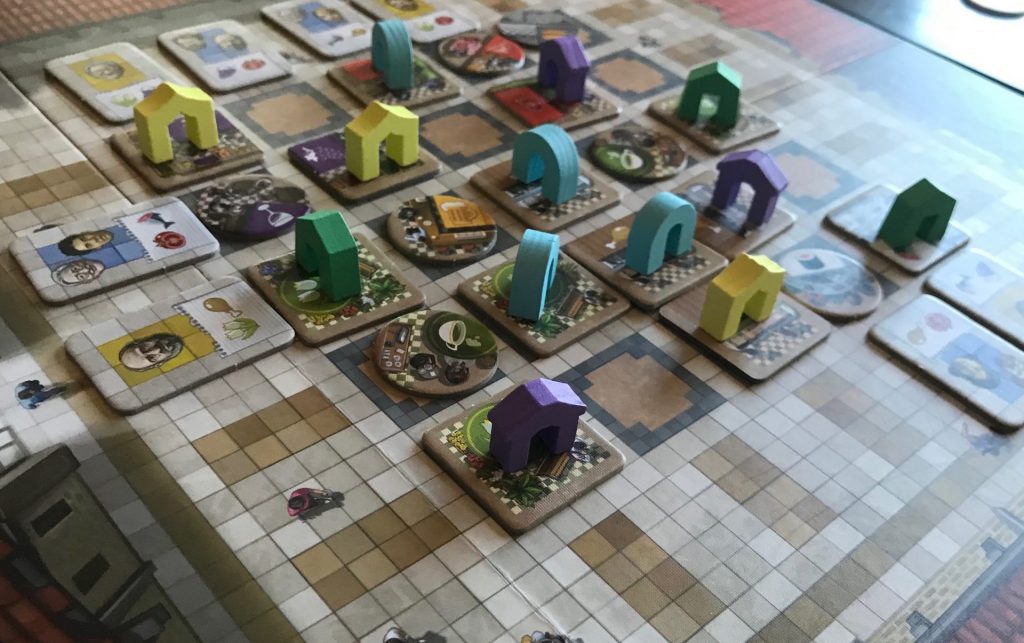
Know Before You Go
In Mercado de Lisboa 2-4 players are seeking to become the wealthiest entrepreneur in a modern-day market by bringing in customers to shop for goods from Stands while strategically installing Restaurants to further increase the value of those Stands.
The Lisbon Market board is a 5 x 5 grid where Stands and Restaurants will be placed. Surrounding this grid are 20 spaces for customers to enter the market (one Customer at the end of each row and column). Players will choose a color of wooden tokens to represent the Stands they own and each player starts with 1 Euro coin that is placed behind a screen where money is kept throughout the game.
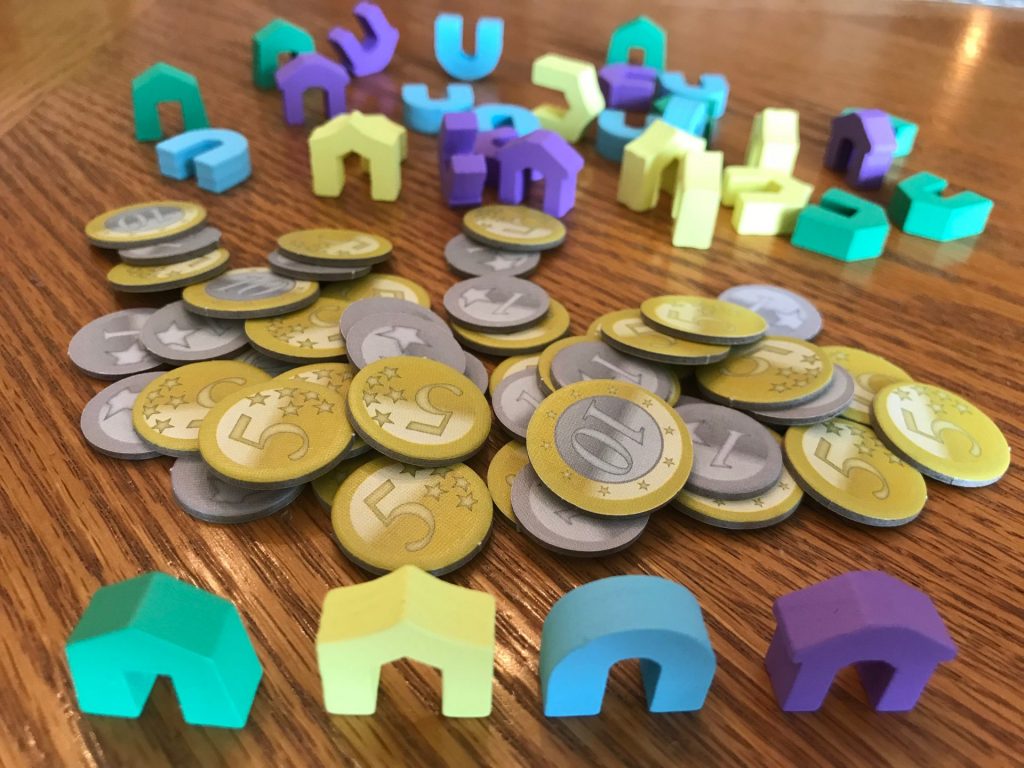
There are only four actions that players can perform in the game and on their turn each player will choose one. This a trademark of Lacerda games I’ve grown to appreciate; typically you take only one action that splinters into a chain-reaction of effects. The four actions are as follows.
Open a Stand
Stands are square tiles that contain one of five different goods types with associated colors: tomatoes (red), flowers (green), grapes (purple), meat (brown), and fish (white). Stands cost money. They are 1 Euro each plus one Euro for each other Stand in the same row or same column, whichever has more. Opening a Stand is a way to generate income once customers are introduced to the market. But Stands must also be built in order to get more customers to shop!
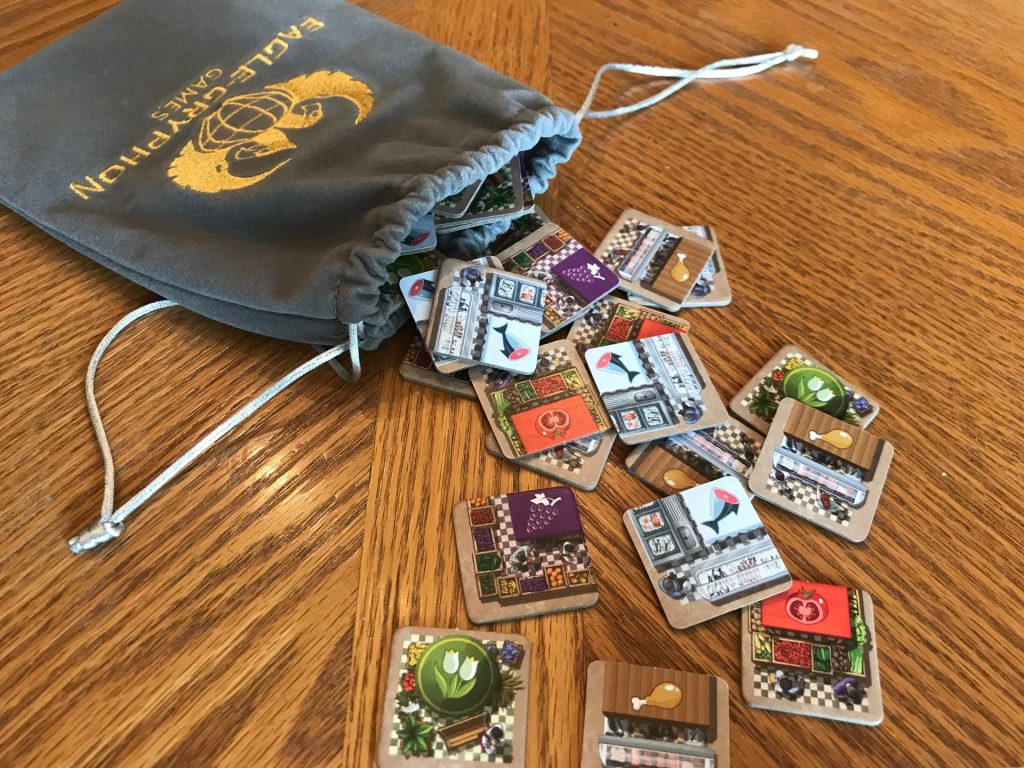
Economically-challenged players can circumvent the required cost to install a Stand through a clever rule that allows players to “build on credit.” You may install a Stand if you are unable to afford it as long as you can pay the cost after installing it and receiving payment from Customer tiles (more on that below). For example, if you intend to install a Stand that would cost 2 coins and you only have 1, but you will receive 1 coin upon installation, you may still place it on the board. Your 1 coin income plus 1 coin in-hand would allow you to pay the 2 coin cost.
Bring Customers
Players can also choose to take a customer tile and place it at the end of any row or column in which they own a Stand that has a good the customers are looking for. Customer tiles show 1, 2, 3, or 4 customers and most have 2 good types that they desire. However, Customers can also only be placed on rows that have Stands equal to or more than the number of Customers on the tile. For example, a Customer tile that has 3 customers can only be placed in a row or column with 3 or more Stands.

When Customer tiles are placed they pay money to every Stand that has goods that they are looking for, even your competition! They give 1 coin for each Stand plus 1 coin for each Restaurant token boosting that stand (more on that below) multiplied by the number of Customers shown on the tile.
Open a Restaurant
Restaurants are circular tokens that amplify the sales power of your Stands. Restaurants “match” the Stands by color and food type: pizza (red), tea (green), wine (purple), burger (brown), and sushi (white). There is a limited number of Restaurants in the game and they start facedown on the board. Players obtain them by installing a Stand or Restaurant on a space where they are located and then collecting the facedown token, flipping it faceup in front of them. On any future turn, players can place the Restaurant token on any space on the board (including overtop a facedown Restaurant token). Restaurants also give a 1 coin payment when they are first built. Functionally they boost any adjacent Stand that matches their food type. For example, a pizza Restaurant will increase the income of each adjacent tomato Stand by one.
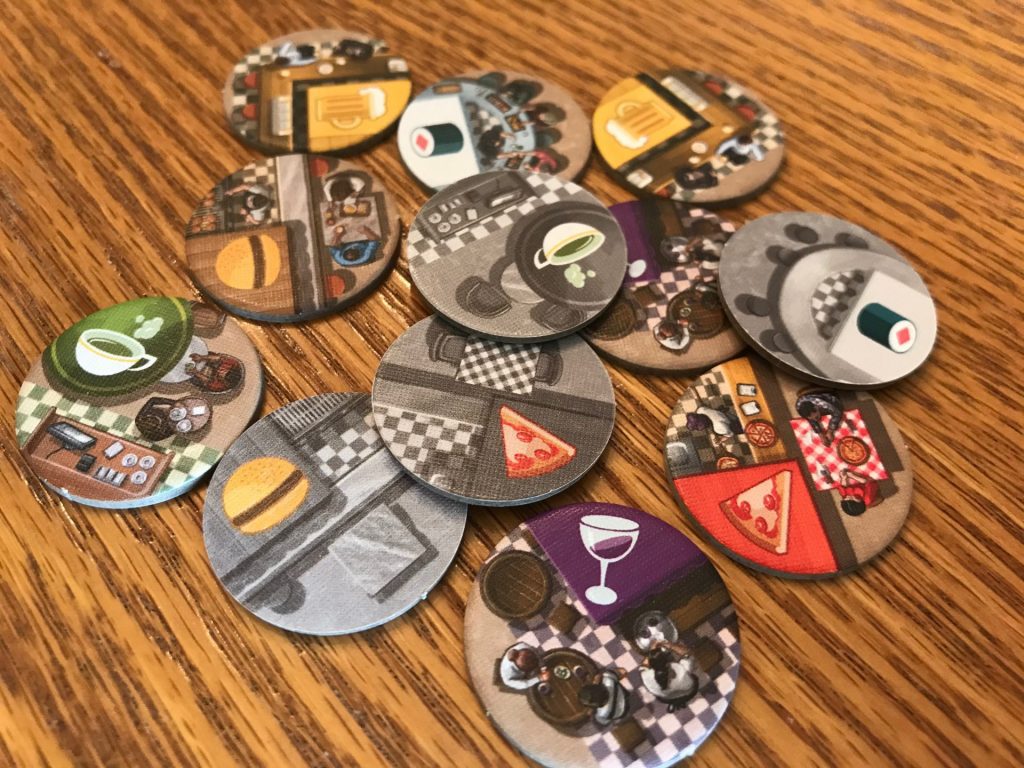
To add one extra wrinkle, there is a pub Restaurant with a beer icon that doesn’t belong to any of the Stand types. The pub Restaurant is a “wild” that will increase the value of any adjacent Restaurant. There’s a commentary about the value of beer in Restauranteering here somewhere.
Take 1 Coin
This is generally a last resort that you can do if you run out of money and there’s nothing else to do. Avoid this action at all costs. But I will confess I had to take this action in one game after boisterously claiming it’s the “action of shame.”
Closing the Market
The end of the game is triggered when a player builds a Stand or Restaurant that leaves only four spaces left in the market, or the player places a Customer tile and leaves only four entrances left for Customers. At that point, each other player gets one more turn. Then players add up their coins and the player with the most wins.
Shop Til You Drop
One of the refreshing nuances of Mercado de Lisboa is that it really is simple to teach. I even taught my 5 year-old how to play (he didn’t grasp the strategic nuances, but he understood the color-matching placement aspects). With only four actions to review, it’s a fast teach. With a quick and simple rules explanation, you can pull this game out with folks who are new to gaming or haven’t played all the Eagle-Gryphon classics proudly displayed on your shelf.
It can be hard to find deep Euro-style games that play in a 30-45 minute timeframe. I’m often in the mood to play something that emphasizes strategy over luck under a tight timeframe without an exhausting mental commitment. Some modern games like Azul fit this niche, but they are often games that employ group-solitaire mechanisms. In Mercado de Lisboa the difference is shared space. You’re drawing from the same pool of components and playing them within a spatially competitive frame.
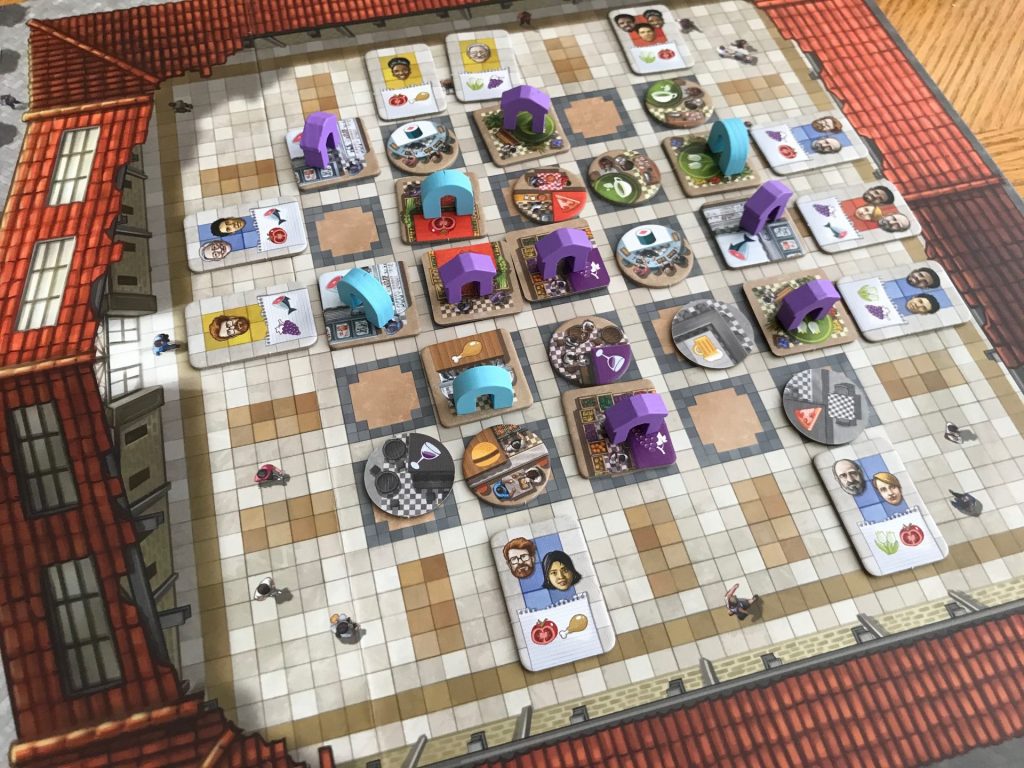
But don’t mistake simple rules to mean a shallow game. It’s true that Mercado de Lisboa is dramatically less complex than Lisboa, but it retains a depth of gameplay that honors Lacerda’s design pedigree. You will feel the tension of your decisions more than a Black Friday shopper on a shoestring budget. Do you go for the cheaper spot on the board (thereby preserving your point total) or go for the more expensive spot that may get more income later in the game? Do you monopolize one Stand and Restaurant type, or do you try to build the same types as your opponents and hope to cash in on their Customer placements? Do you grab that Customer tile now, or do you wait and build more Stands to get more revenue and hope your opponents don’t grab it in the meantime? Offense or defense? Wine or beer?
The layers of gameplay become more or less prominent depending on player count. Two player games are a classic duel. You can see everything your opponent has very clearly and may be able to tell their strategies. Do you try to block them and play defensively? Or stick to your plans to give yourself an offensive advantage? At four players it’s a little more chaotic as the availability of tiles changes much faster, resulting in an increased demand for flexibility. With the depth of strategy offered by a simple ruleset, Mercado de Lisboa is a game that can truly be enjoyed by any level of gamer experience. But is everything in this market as fresh as it appears?
Customer Satisfaction?
While I think that the market setting for Mercado de Lisboa is a satisfactory spinoff of the Lisboa game, it really could have been any theme. I know any feisty keyboard warrior could make this claim, but what I mean is that the mechanisms don’t explicitly tie to being in a market. For example, why does it cost money to install a Stand (raw ingredients) but it does not cost money to build a Restaurant (which in theory could be much more expensive)? In fact players pay for Stands but receive money for placing Restaurants. Those teaching the rules may stumble over terminology trying to remember the difference between Stands and Restaurants because thematically they seem inverse. (I developed a simple memory tool: Restaurants are Round and Stands are Square). From a design standpoint, this sacrifice in theme is meant to keep the rules as streamlined as possible.
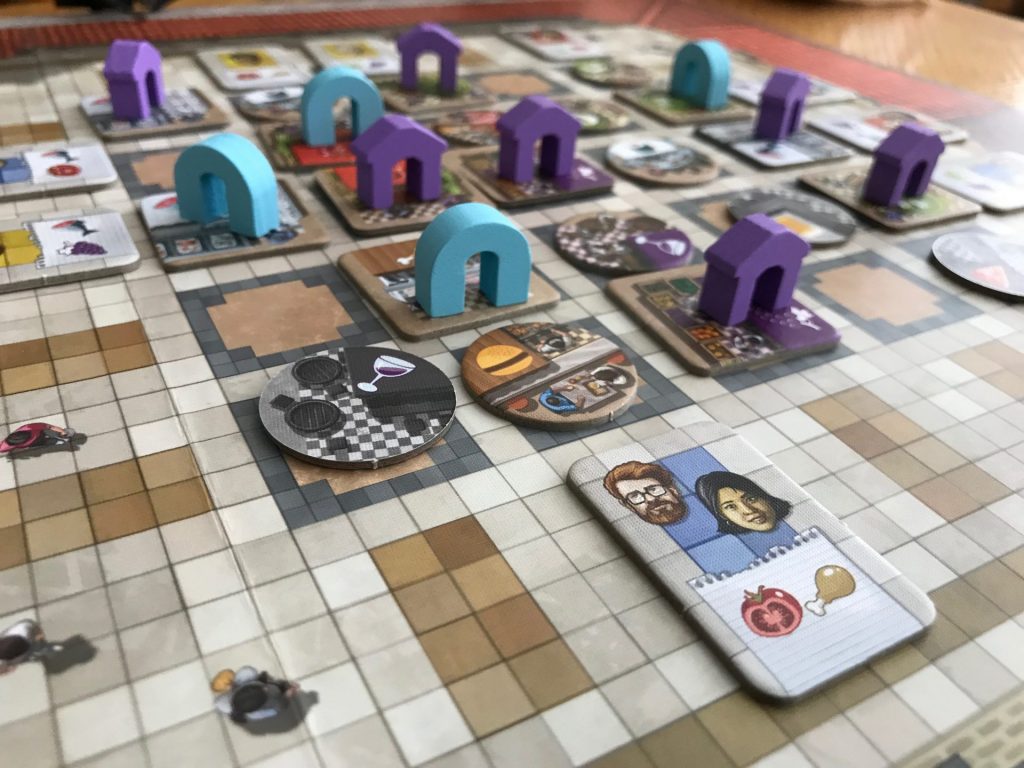
While this game is simple to teach, learn, and mechanically play, it’s also yet another game that has a historical weakness for Lacerda designs: analysis paralysis (AP). Players only take one action on their turn. For AP-prone players, this is a boone. Yet, that one action is layered with a number of decisions such as: which tile do I place, which spot on the board do I place it, do I wait to place it and instead take a customer, which tiles most likely will disappear before the next turn? Because the gameplay is deep, there are a number of things to pay attention to in order to play well, including what your opponents have placed on the market board and have in front of them, and the synergistic combinations of Customer tiles and available Restaurant tiles in the market. Most games will stick to the 30-45 minute timeframe, but with AP players this could be drawn out.
Finally, players who are used to elaborate artwork and copious components found in other Lacerda games may be surprised to find the pieces here are somewhat unremarkable. Functionality is the name of the game here; artwork is crisp and colorful, the graphic design is clear. But nothing will stand out like artist Ian O’Toole’s intricate azulejos board of Lisboa. I did find myself wondering what it might have looked like to keep that tile design for this game.
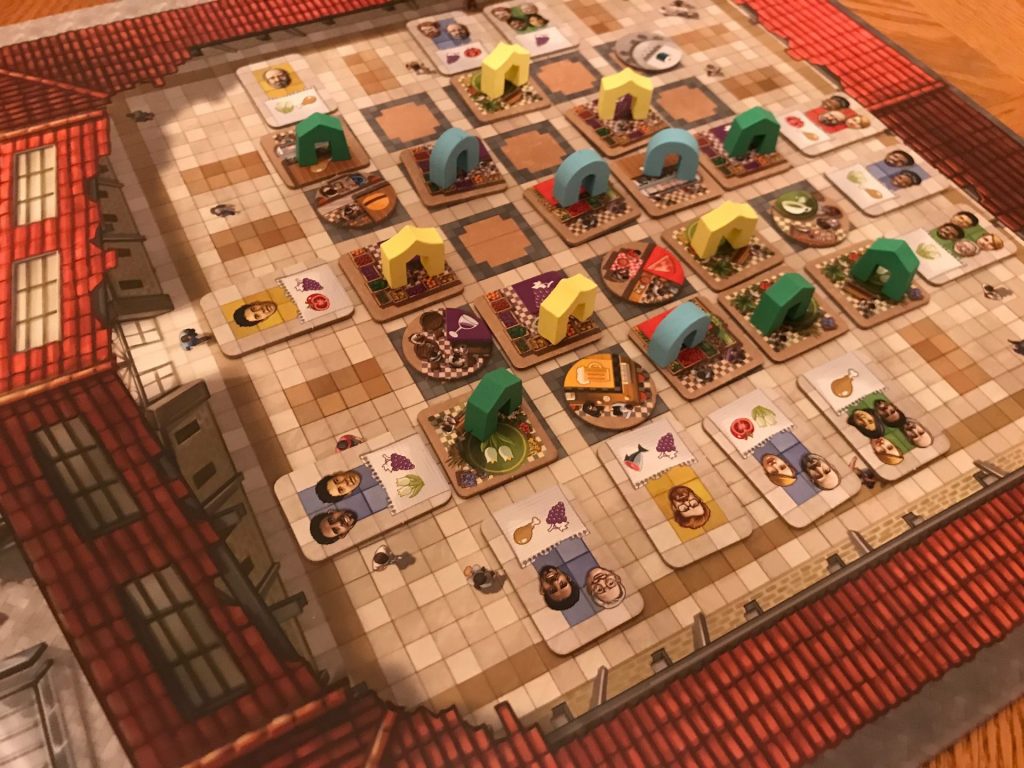
MercaDo or Don’t
Mercado de Lisboa absolutely lives up to the advertised claims. It is the strategy gamer’s “filler” game that also functions perfectly well as an introductory game for newer gamers. Built upon an already well-crafted design, the depth of gameplay is supported by simple but tight mechanisms. Beyond that I found a number of moments where I felt “this feels like Chess or Othello!” Gamers looking for a spatial puzzle of these classic games will find a lot to like here.
I’ve roamed around ancient-modern markets in Lisbon and a number of other countries in Europe and there is a distinct feeling standing in the presence of something that simultaneously displays rich history and caters to modern tastes. And much like its thematic subject, Mercado de Lisboa is one of those rare games that feels both classic and modern at the same time.


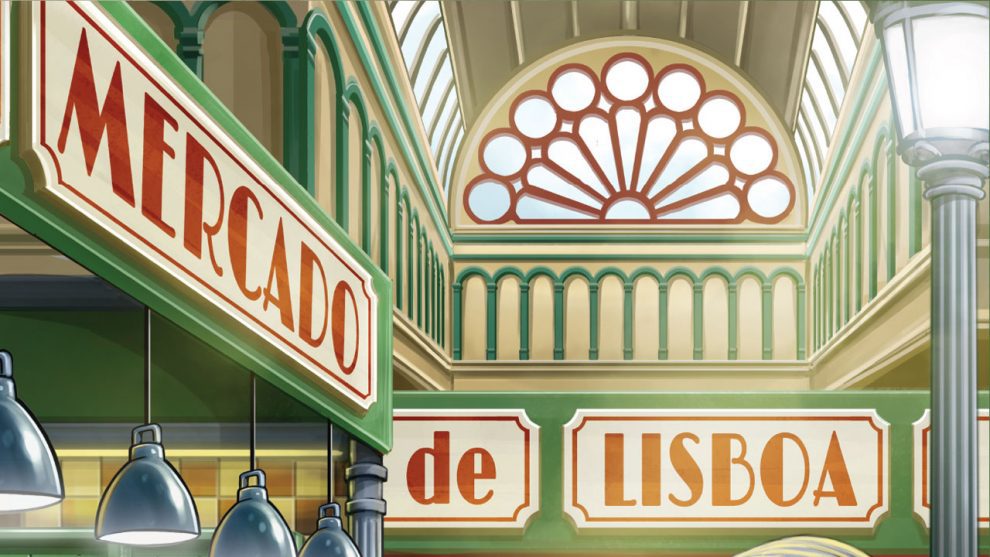









Thanks for this! I’ve been interested in it!